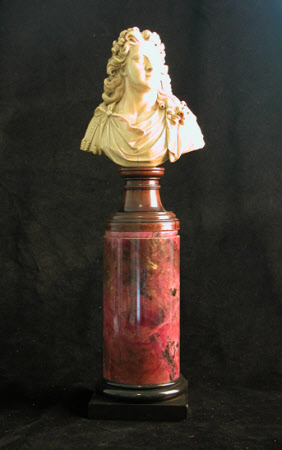Portrait of a man, perhaps Paris Slaughter
David Le Marchand (1674 - 1726)
Category
Art / Sculpture
Date
1700
Materials
Ivory and rose marble
Place of origin
Great Britain
Order this imageCollection
Anglesey Abbey, Cambridgeshire
NT 516587
Summary
Ivory on rose marble, Portrait of a man, perhaps Paris Slaughter (d. 1703), David Le Marchand (1674-1726), 1700. An ivory bust of a gentleman, possibly a portrait of Paris Slaughter (died 1703), an Huguenot gentleman. The sitter is shown dressed in an all’antica cuirass, visible at the right shoulder but otherwise largely concealed beneath a cloak, fastened at the right shoulder with a brooch. He wears a flowing wig. Signed on the reverse of the bust 'DD. LE MARCHAND SCVLT. AN. DO. 1700' ('David Le Marchand sculpted this in the year of Our Lord 1700’). On the underside of the wooden base is a deteriorated handwritten paper label, with an inscription incorrectly identifying the sitter as Louis de France, the Grand Dauphin (1661-1711), heir to the French throne. On a turned wooden socle and rose marble column.
Full description
David Le Marchand was one of many Huguenot artists and craftsmen who left their native France to settle in Britain, after the Revocation of the Edict of Nantes in 1685 put an end to an official policy of religious tolerance towards the Protestant faith in France. He was born and grew up in Dieppe, for centuries the historic centre of ivory carving in France, and is first recorded in Britain in Edinburgh, where he was permitted in 1696 to open a shop. His early works in Britain include many portraits of Scottish aristocrats. At some point, perhaps around 1700, he moved to London, where he lived for the remainder of his career, dying in poverty in 1726. Le Marchand’s output includes many portraits, reflecting the British predilection for portraiture over figurative and historical subjects. Many of his clients came from the thriving Huguenot community, but he also made portraits of members of the aristocracy and gentry. The refined portrait bust at Anglesey Abbey was long thought to depict Louis, the Grand Dauphin (1661-1711), eldest son and heir of King Louis XIV of France, not least because underneath the wooden socle of the bust is a long handwritten inscription bearing this identification. The bust however does not closely resemble portraits of the Grand Dauphin and, unless he had been commissioned by a Jacobite supporter in Scotland or in England, it might in any event seem unlikely that Le Marchand would have wished to make a portrait of one of the principal figures in the regime that had introduced punitive measures against Protestants in France. When the bust was exhibited in a major monographic exhibition on David Le Marchand held in 1996, it became clear that the bust was in fact the pair to a portrait bust of a woman, signed and dated 1701, probably a member of the Nelthorpe family (Tessa Murdoch, ed., The Quiet Conquest. The Huguenots 1685 to 1985, exhibition, Museum of London, 1985, pp. 210-11, no. 306; Avery 1996a, p. 99, no. 77; Avery 1996b, p. 29, no. 104). The Nelthorpe family, although based in Lincolnshire, had strong London connections in the early 1700s. The bust of a woman has been generally identified as a portrait of Anne Nelthorpe (née Hobson), who married Henry Nelthorpe in 1694. After Henry’s death in 1698, his widow remarried in 1699, to Paris Slaughter, who in turn died in 1703. If the woman is Anne Nelthorpe, then it would seem likely that both busts were commissioned by Paris Slaughter, about whom nothing further is currently known. Jeremy Warren 2019
Provenance
Sotheby’s London, 22 February 1949, lot 66, sold for £70 to ‘Griffin’; purchased by Urban Huttleston Rogers Broughton, 1st Lord Fairhaven (1896-1966); bequeathed by Lord Fairhaven with the house and the rest of the contents.
Credit line
Anglesey Abbey, The Fairhaven Collection (The National Trust)
Makers and roles
David Le Marchand (1674 - 1726), sculptor
